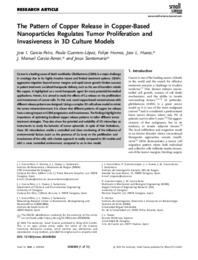Título :
The Pattern of Copper Release in Copper-Based Nanoparticles Regulates Tumor Proliferation and Invasiveness in 3D Culture Models |
Autor :
Garcia-Peiro, Jose I.
Guerrero López, Paula 
Hornos, Felipe
Hueso, José L. 
Garcia-Aznar, José Manuel 
Santamaria, Jesus |
Editor :
Wiley |
Departamento:
Departamentos de la UMH::Agroquímica y Medio Ambiente |
Fecha de publicación:
2024 |
URI :
https://hdl.handle.net/11000/35636 |
Resumen :
Cancer is a leading cause of death worldwide. Glioblastoma (GBM) is a major challenge
in oncology due to its highly invasive nature and limited treatment options. GBM’s
aggressive migration beyond tumor margins and rapid tumor growth hinders success
in patient treatment. Localized therapeutic delivery, such as the use of transition metals
like copper, is highlighted as a novel therapeutic agent for many potential biomedical
applications. Herein, it is aimed to study the effects of Cu release on the proliferation
and invasiveness of cancer cells. To this end, novel copper-based nanostructures with
different release patterns are designed. Using a complex 3D cell culture model to mimic
the tumor microenvironment, it is shown that different patterns of copper ion release
have a strong impact on GBM progression and invasiveness. The findings highlight the
importance of optimizing localized copper release patterns to tailor different tumor
treatment strategies. They also show the potential and suitability of 3D microchips as
instruments to study the behavior of tumor spheroids. In spite of their limitations,
these 3D microdevices enable a controlled and close monitoring of the influence of
environmental factors (such as the presence of Cu ions) on the proliferation and
invasiveness of the cells, with a better approach to reality compared to 2D models and
with a more controlled environment, compared to an in vivo model.
|
Área de conocimiento :
CDU: Ciencias puras y naturales |
Tipo de documento :
info:eu-repo/semantics/article |
Derechos de acceso:
info:eu-repo/semantics/openAccess
Attribution-NonCommercial-NoDerivatives 4.0 Internacional |
DOI :
https://doi.org/10.1002/smsc.202400206 |
Publicado en:
Small Science, 2024, 4 |
Aparece en las colecciones:
Artículos Agroquímica y Medio Ambiente
|

 La licencia se describe como: Atribución-NonComercial-NoDerivada 4.0 Internacional.
La licencia se describe como: Atribución-NonComercial-NoDerivada 4.0 Internacional.
.png)